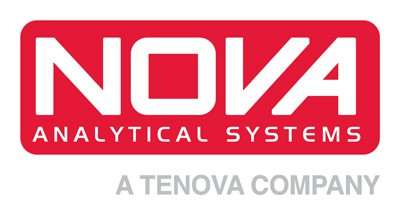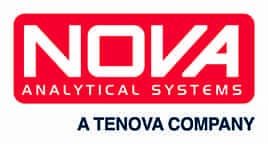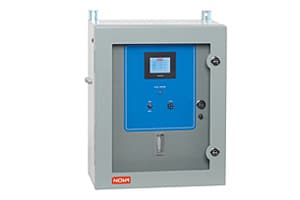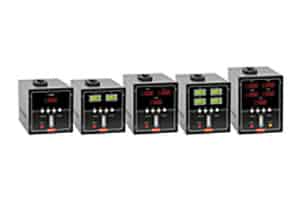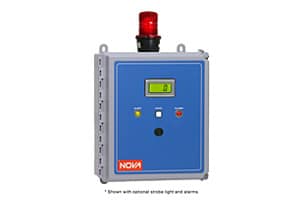Heat-Treating and Metal Finishing Analyzers
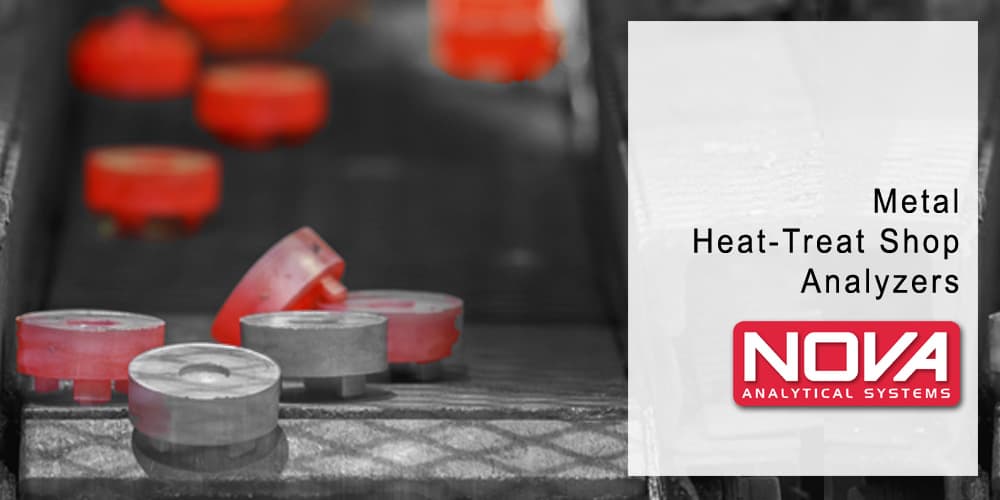
Nova 7900 Series Continuous Heat Treat Analyzers
Nova 7900P Series Portable Heat Treat Analyzers
Nova 7200 Series Continuous Flue Gas Analyzers
Nova 810 Series Continuous Oxygen Analyzers
(Titanium Application)
Heat Treating Analyzer Catalog
Discussion
Gas analyzers can be used for monitoring atmosphere gases and flue gases in steel finishing and heat treating furnaces in steel mills.
After molten steel is produced by the melt shop, it usually then requires shaping and finishing in rolling mills, bar mills, blooming mills, wire mills, etc. Gas analysis in these mills are generally classified as being either flue gases or atmosphere gases. Many mills also require gas monitoring of the ambient air around furnaces for safety purposes.
Furnace Flue Gas
Molten steel may be directly cast into slabs or continuously rolled out into strips. The slabs and strips may be further processed into other finished products such as bars, billets, beams, or wire. The slabs may be stored and processed later, while continuous strip lines produce a finished coil. In either case, a reheat furnace will be required to bring the steel back up to even temperature for finishing. An even temperature profile in the steel is desirable to promote even rolling and finishing. The steel needs to ‘soak’ in the heat. Re-heat furnaces are therefore also frequently called heat soak furnaces.
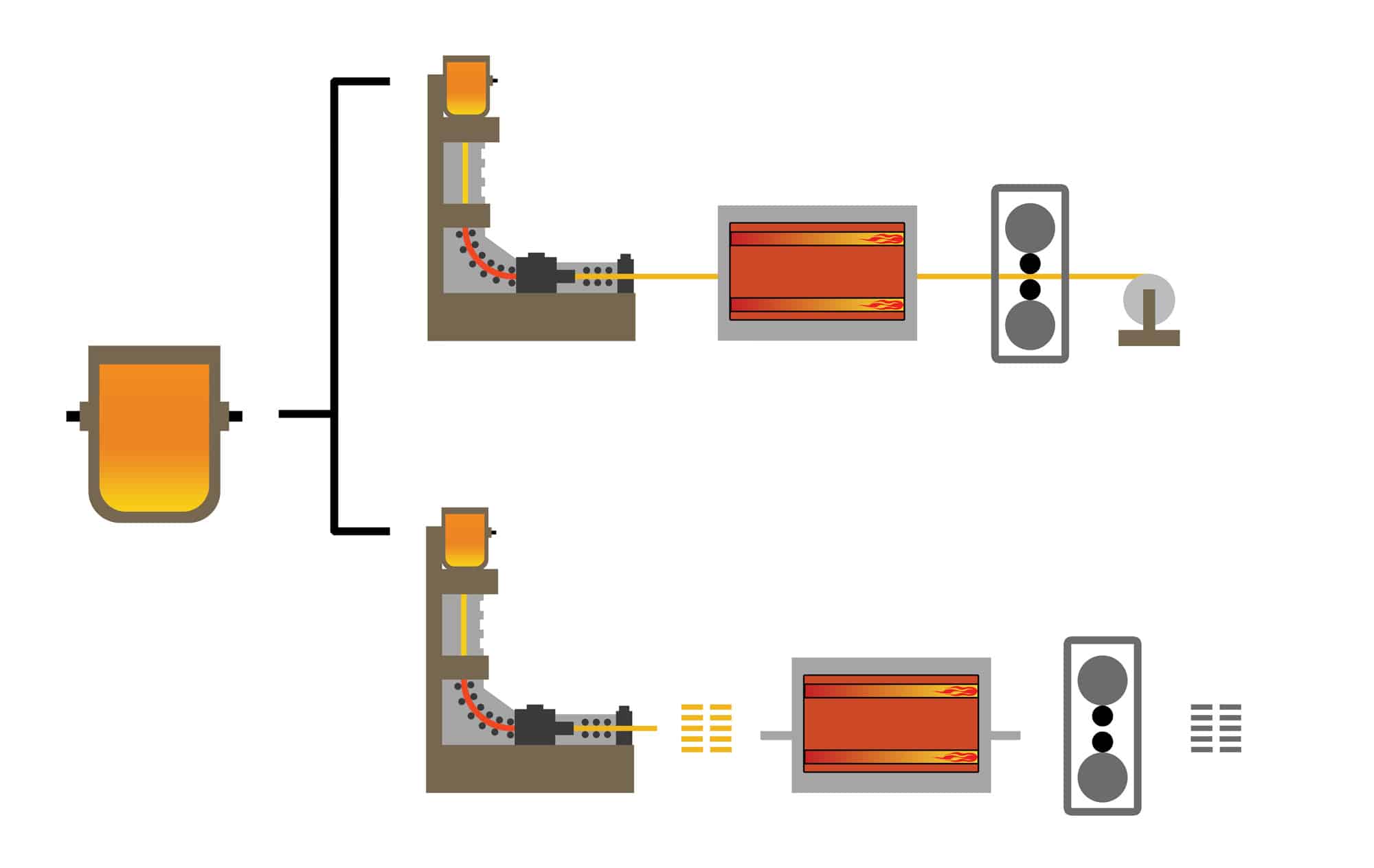
The heat is usually produced by burning natural gas through a series of isolated burners in the furnace. The flames are contained in a series of tubes in the furnace and are isolated from the furnace atmosphere. The heating is indirect because it radiates out the tubes and into the furnace. Analysis of flue gas emerging from the tubes is used to determine if the fuel is being efficiently and safely burned. It is also useful in determining if a tube has cracked and is leaking into the furnace atmosphere. A gas analyzer will provide this measurement. The NOVA 7200 Series will provide continuous analysis of common flue gases such as oxygen, carbon monoxide, carbon dioxide, nitrogen dioxide, and others.
Nova 7200 Series Continuous Flue Gas Analyzers
- Continuous analysis of flue gases
- O2 / CO / CO2 / NO
- Long-life sensors / detectors
- Sample conditioning built into analyzer cabinet
- Microprocessor control with push button calibration
- Easy-to-maintain modular layouts
- Built-in sample motivation included
- 4-20mA recorder outputs

Atmosphere Gases
Coils or strips produced by the finishing mills may be further processed into specialty steel products with specific finishes, sizes, or hardness. One example is annealing. After rolling operations, the steel will be work-hardened and will need to be annealed to restore the desired ductility. Annealing furnaces require heat and a specific operating atmosphere to remove the carbon from the steel. Carburizing furnaces use heat and specific atmospheres to add carbon and hardness to manufactured steel parts. The specific atmosphere will depend on the type of heat treating. Heat treat furnaces are different from re-heat in that the produced atmosphere is in direct contact with the steel instead of being isolated.
Heat treat atmospheres may be comprised of oxygen, carbon monoxide, carbon dioxide, hydrogen, or methane. The specific atmosphere will depend on the type of heat treating. The NOVA 7900 Series can be configured to provide measurement of all of these gases in the single instrument.
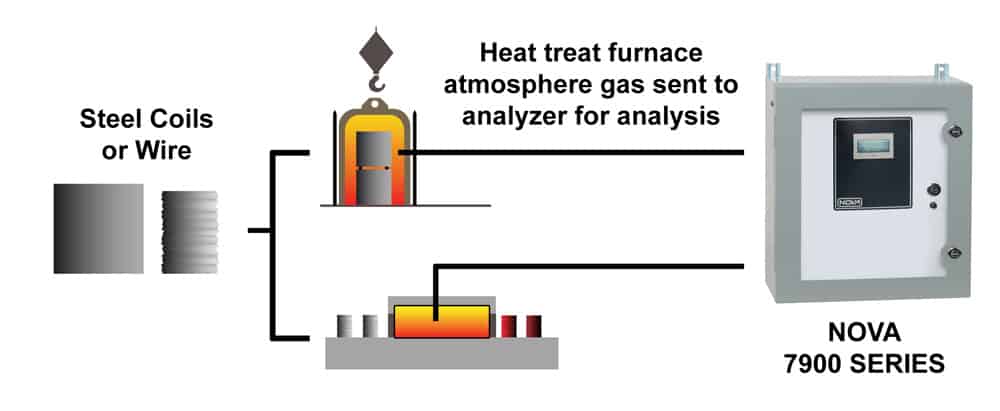
NOVA 7900 Series Heat Treat Gas Analyzer
- Continuous analysis of atmosphere gases
- O2 / CO / CO2 / CH4 / H2 / Dew Point available
- Long-life sensors / detectors
- Sample conditioning built into analyzer cabinet
- Microprocessor control with push button calibration
- Easy-to-maintain modular layouts
- Built-in sample motivation included
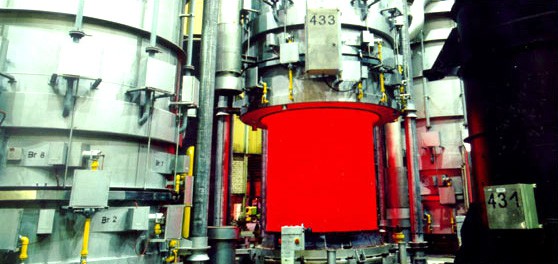

Titanium Milling Application – Background
The manufacture of the specialty titanium powders starts in the Milling Plant, where the raw material is chemically treated and heated which results in flat, formed slabs. The slabs are then mechanically pulverized to reduce the material size, impart flow properties, and enable further processing. The resultant material is sifted and filtered to extract products that are small enough to be more finely milled.
A quantity of the extracted semi-refined powder is emptied into a hopper. At the base of the hopper is a vibrating platform which agitates and mobilizes the powder, causing it to flow out of the hopper and through a feed tube towards the mill. In the mill, the powder is ground to a final consistency and is captured in a drum beneath the mill. The drum is sealed and stored for market or other subsequent refinement or manufacturing processes.
Hazard
Powdered metals such as titanium, aluminum, and magnesium, can form explosive dispersions in air, if combined with the right enabling factors. A vibratory ball mill may produce internal sparks which can serve as an ignition source. The titanium milling process is sometimes operated at elevated temperatures, which may assist in promoting ignition. The resulting titanium powder is very finely divided and has an affinity for oxygen (O2), which further exacerbates the potential for fire and dust explosion hazards during powder milling operations.
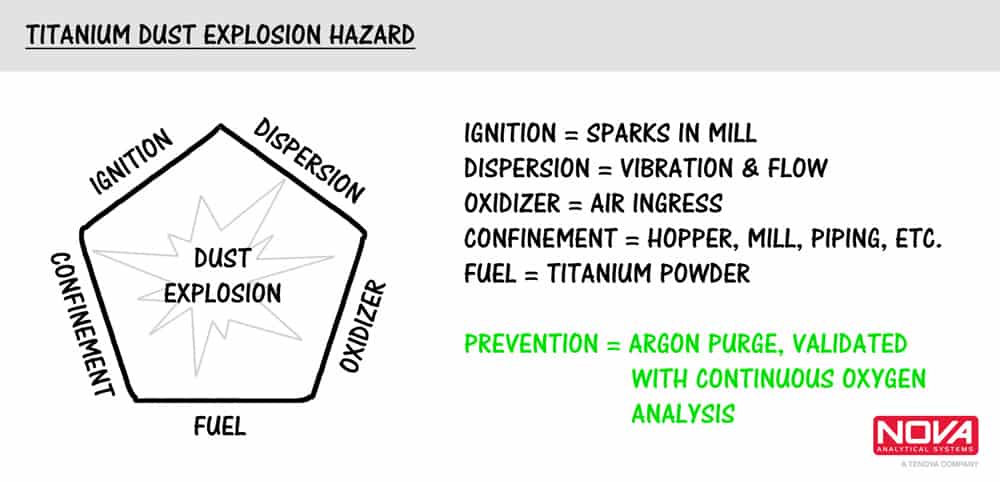
To reduce the risk of ignition, an Argon blanket is introduced into the mill to provide an inert non-flammable environment throughout the inside spaces of the collecting drum, grinding mill, feed tube, and hopper. The inert blanket of Argon gas displaces oxygen from the milling process path. The inert blanket will not support combustion, thereby eliminating the potential for titanium powder ignition from the various ignition points and other combustion-favorable conditions created inside the mill.
Argon Blanket
While adding Argon to the milling process greatly reduces the risk of ignition, there are still some residual risk factors. Two potential unknowns:
- The collecting drum beneath the mill can be installed improperly such that the interface between the drum and the mill base does not have a good seal. Loss of Argon blanket and air ingress can result.
- The completeness of Argon blanket is difficult to verify throughout the geometrically complex mill components. If oxygen has not been sufficiently purged from the collecting drum and up through the cavities in the mill, the operator cannot safely activate the mill.
Extracting a continuous sample of the Argon blanket at a point that is downstream from the injection point, and measuring for O2, will detect deficiencies or breaches in the Argon blanket. As the Ar blanket is introduced, the O2 level should gradually diminish from 20.95% (normal Air) to zero percent. This will indicate that the O2 has been fully displaced from the mill and that the Ar blanket is complete. (No doubt the internal geometry of the mill system are also configured in such a manner so as to avoid negative spaces where pools of O2 might be trapped and resist displacement.)
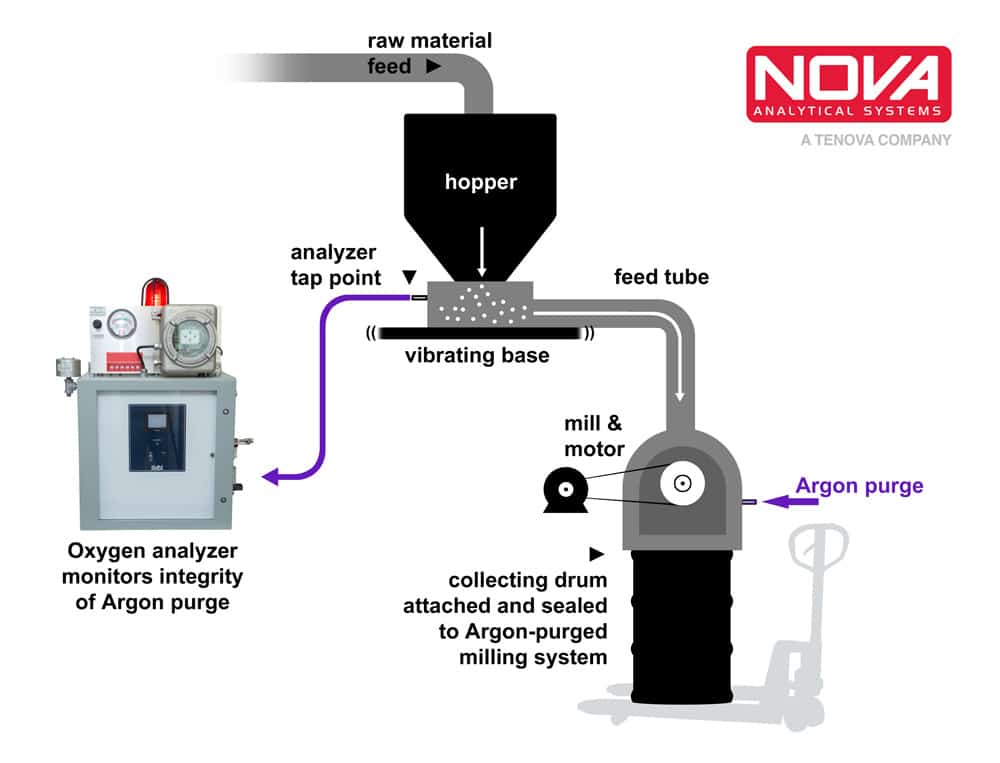
Argon Blanket Monitoring Using Gas Analyzers
Using a continuous gas analyzer is the correct approach for determining the completeness of the O2 purge. However, given the nature of the sample (gas flowing through fine flowing powder), there are valid concerns that a typical extractive gas analyzer will suffer from reliability issues and premature failure of sample motivation components.
As a good starting point to address these concerns, the O2 analyzer requires rugged wetted-train components, stainless steel tubing and fittings, and a high capacity sample pump. These items offer a good balance between sample extraction power and reliability, durability, and internal leak prevention.
In addition to being a potential explosion risk, the finely-divided powder can accumulate in the tubing & components of the O2 analyzer and reduce flow. As the flow drops, the analytical response to changes in the process atmosphere also slows down, introducing a potentially-dangerous time delay in alerting the human operators or the receiving automation devices. If the flow ceases entirely, the mill system will be left un-monitored.
Sample Filtration & Filter Blowback
To protect the internal flow path of the analyzer, a particulate pre-filter is installed at the sample extraction point. While the pre-filter does protect the analyzer, it becomes loaded with particulate and will also cause an increasing degree of flow reduction. To address this concern, a filter ‘blowback’ feature in the analyzer can be utilized. This feature enables a timed pulse of clean gas (Argon in this case) to blow back in the reverse direction through pre-filter to push out the accumulated dust.
In typical flue gas applications, this feature is accompanied by an externally mounted probe & heated filter cabinet, which are installed at the stack. In the titanium powder application, some of these components are not appropriate. For example, the sample extraction point cannot accommodate the intrusion of a probe. Since the entire operation is located indoors, and the sample gas is not a hot combustion product, a heated filter cabinet may also be unnecessary.
To keep the design simple, a basic pre-filter with a fine glass fiber element can be installed at the sample extraction point. The control for the blowback feature is integrated inside the analyzer cabinet. The blowback event is commanded either by a calendar-driven timer in the HMI or by using an external manual pushbutton actuation when needed. During blowback, the blowback solenoid valve (SV5 in Figure 3) is actuated. This causes high pressure Argon to bypass input filter located at the analyzer, and flow up though the sample line to the pre-filter to clean off the dust. The blowback feature extends the life of the pre-filter, improves flow, and reduces the frequency of filter replacement.
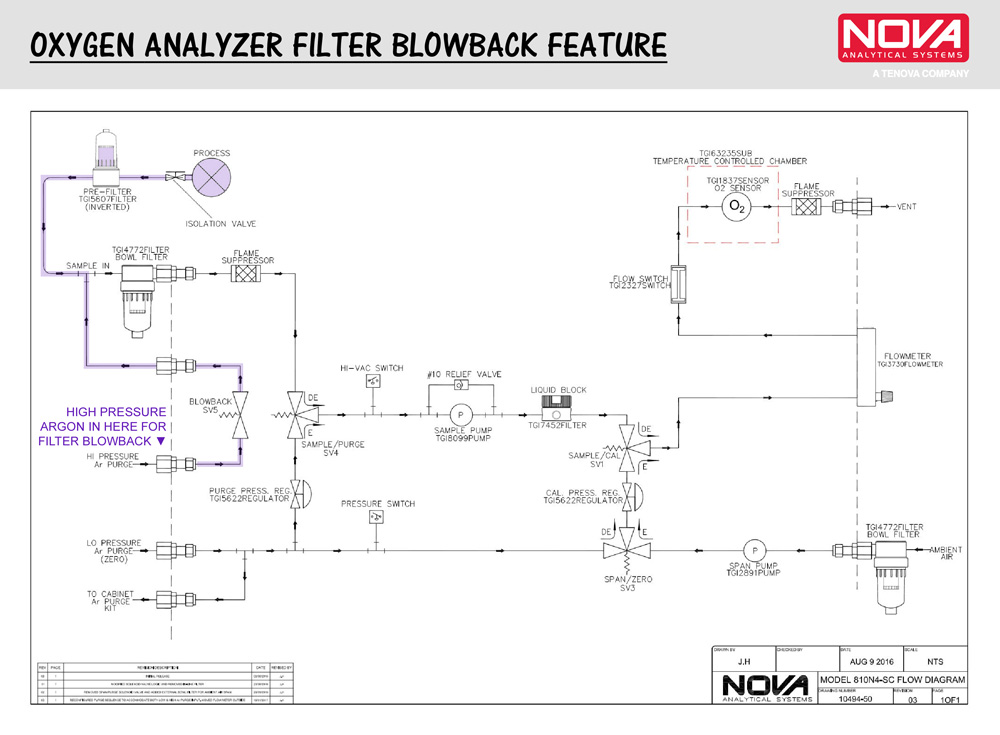
Hazardous Area Rating and Continuous Operation
The reactive nature of the metallic powder usually results in the mill environment being designated as hazardous rated area. The turnkey nature of the NOVA analyzer products allow all the additional features and capabilities to be packaged inside of one cabinet that is equipped with a Class 2 Division 1 rated hazardous area purge panel.
One necessary condition of the purge panel is that the purged atmosphere inside the analyzer cabinet be maintained at all times. If the cabinet atmosphere is compromised, it will trigger a pressure switch interlock between the purge panel and the analyzer power supply, thereby de-powering and shutting down the analyzer. This will remove the analyzer as a potential source of arcing ignition. However, this will also leave the titanium mill atmosphere unmonitored for an unnecessarily long time.
To alleviate this condition, the NOVA ‘DuraNOVA’ series analyzer offers as a standard feature a ‘CALNOW’ switch that can be activated from outside the analyzer by a magnetic wand without needing to open the door. When activated, the analyzer will undertake a full automatic calibration without any further intervention by the operator. In addition, the flowmeter, flow adjustment valve, final filter, and cabinet air filter can all be checked and accessed from outside the cabinet without interrupting the purge. The on-demand blowback push-button mentioned earlier is also rated for hazardous areas.
Results & Operation
Best results are obtained in this application when the stakeholders have committed to regular preventative maintenance activities on the analyzers including weekly purge of the pre-filters and quarterly calibration. As a result, unexpected failures due to loss of sample flow from powder blockages or component failures are prevented.
In addition, the NOVA analyzer has an O2 control alarm that can be connected to an interlock that controls power to the titanium mill and vibrating table. In this way, the milling cell cannot be energized until the measured O2 level in the Argon atmosphere is below the analyzer alarm set point. Since introducing the O2 analyzers and establishing the interlock between the analyzer and the mill power in one titanium plant in the USA, none of their milling stations have experienced any ignition events.
Ambient Air Safety Monitoring
The atmospheres and products of combustion associated with many steel-making operations contain toxic gases that can cause injury or death to nearby staff. This is especially the case in confined spaces and areas where gases are stored in tanks and cylinders. A gas may be directly harmful because of its chemistry, or it may be indirectly harmful because it displaces oxygen.
The NOVA 500 Series Monitors can monitor ambient air for various gases. A visible and audible alarm will alert nearby staff that a potentially dangerous condition exists.
NOVA 500 Series Ambient Air Monitors
- Continuous monitoring of ambient air
- O2 deficiency, CO, CO2 and others available
- Long-life sensors / detectors
- Sensors are easy to replace when needed
- Built-in sample motivation included if needed
- 4-20mA recorder outputs
- Two-point alarm package available with horn and strobe light
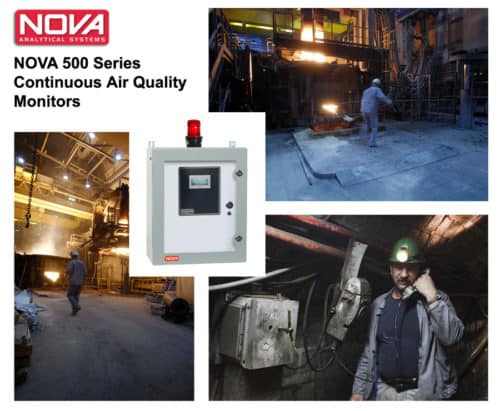
Ready for the next step? Please contact our Sales team for more information or view products here.
